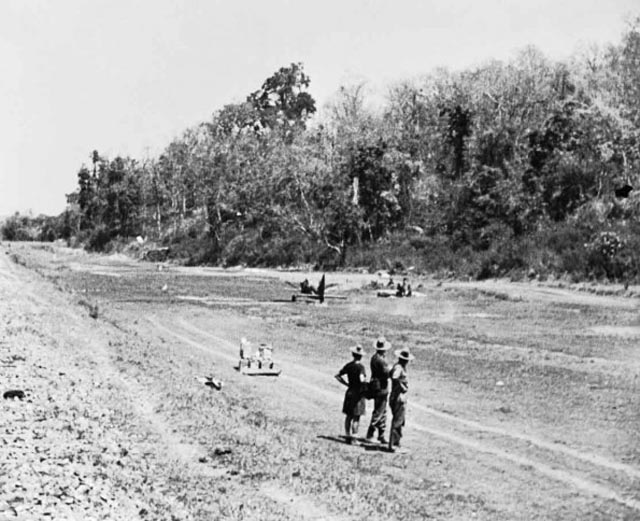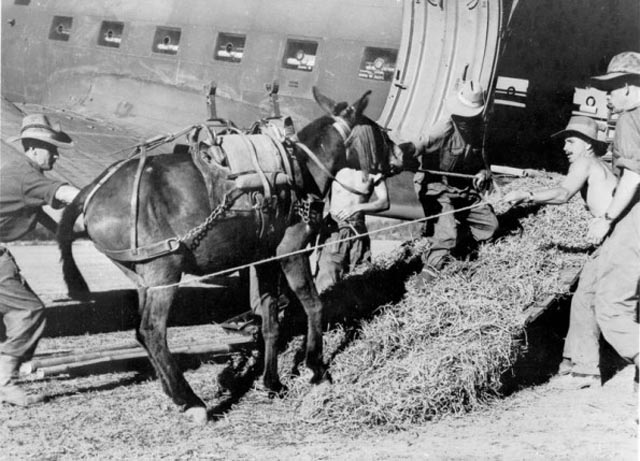Air Operations, Carolines
- 45-five XIII Bomber Command B-24s attack the Truk Atoll.
- During the night, VII Bomber Command B-24s attack the Truk Atoll.
Air Operations, CBI
BURMA- 10 7th Heavy Bomb Group B-24s and more than 70 10th Air Force B-25s and fighter-bombers attack numerous targets in the Mogaung Valley.
- 12 A-31s attack the Buthidaung area.
- 16 459th Fighter Squadron P-38s attack the airfields at Aungban and Kangaung.
- 14th Air Force P-40s attack junks in Fan Tou Bay (China) and motor vehicles at Mong Ho Pung and Wan Pa-Hsa.
- A 459th Fighter Squadron P-38 downs a Ki-43 'Oscar' fighter over the Kangaung airfield at 1125 hours.
- More than 60 10th Air Force A-31s attack Bishenpur and Kohima, and a bridge at Kalewa (Burma).
- More than 30 14th Air Force P-40s attack rail cars at three locations.
Air Operations, Europe
RAF BOMBER COMMANDEvening Ops:
- 506 aircraft are sent to bomb railway yards at Courtrai, Dieppe, Ghent, Lens and Lille. In this total are 291 Lancasters, 187 Halifaxes and 28 Mosquitos. There are no post-raid recon flights over Dieppe, so results there are not known. All other sights are accurately bombed, although some bombs fall on civilian housing.
- 12 Lancasters are lost on the Lille raid and 1 from the Dieppe raid.
- 29 Mosquitos are sent to Ludwigshafen, 2 to Châteaudon, 26 aircraft lay mines off Brest and Heligoland, 28 aircraft are on Resistance operations, and there are 9 Intruder and 3 Serrate patrols and 5 RCM and 10 OTU sorties.
- 1 mine-laying Halifax is lost.
BELGIUM:
- 9th Air Force B-26s, P-47s, and P-51s attack airdromes, marshalling yards, and V-weapons sites.
- 9th Air Force B-26s, P-47s, and P-51s attack airdromes, marshalling yards, and V-weapons sites.
ITALY:
- 12th Air Force B-25s attack bridges at five locations.
- 12th Air Force B-26s attack bridges near Arezzo.
- XII TAC fighter-bombers attack numerous road and rail targets.
AUSTRIA:
- Despite bad weather along the bomber route that results in many aborts, 126 15th Air Force B-24s and 174 B-24s attack the Wiener-Neustadt Bf-109 plant with 795 tons of bombs.
- 102 B-24s attack the Wiener-Neustadt/Nord Airdrome with 212 tons of bombs.
- More than 200 15th Air Force fighters provide escort for the heavy bombers. P-38 pilots of the 1st, 14th and 82nd Fighter Groups account for 13 Luftwaffe fighters on the way to or over the target.
- 28 heavy bombers and 3 escort fighers are lost
- 19 15th Air Force heavy bomers unable to join the main attack on Wiener-Neustadt drop their bombs on Knin.
Air Operations, New Guinea
- 2 V Bomber Command B-24s attack the Mokmer airfield on Biak.
- 5th Air Force B-24s, A-20s, and fighter-bombers mount more than 120 sorties throughout the day against targets of opportunity between Hansa Bay and Wewak.
CBI
BURMAThe Chinese 198th Division Y Force, or the Chinese Expeditionary Force consisting of the Chinese 116th and 190th Divisions, under command of Gen Wei Li-huang advised by Brig-Gen Frank Dorn, crosses the Salween River at Megta Ferry to join the offensive to drive the Japanese out of north Burma and open the Burma Road.
INDIAOn the Indian front the British IV Corps re-groups. The 23rd Indian Div is given the task of manning the Palel-Tamu road, the 20th Indian Div moves toward Ukhrul in 2 columns.
[Eastern Front
The German High Command announces: 'The ruins of Sevastopol were evacuated in the course of a disengaging move.'
SOUTHERN SECTORSoviet forces launch a ferocious attack upon the Khersonnes Peninsula but are repulsed. As fighting rages on the cliff tops, 15,000 soldiers are evacuated by sea.
[Italy
Allied military commanders at Caserta put the finishing touches to the plan for the next day's offensive at Cassino. The operation is based on breaking through the enemy front on the right wing of the German 10th Army so as to be able to reach the Via Casilina. The Allies are deploying the US 5th Army on the left, with the American II Corps in the south and French Expeditionary Corps further north covering the Tyrrhenian coast sector at the confluence of the Liri and Gari Rivers. The US 36th Div is in reserve. On the right of the Allied line there are deployed, from south to north, the British XIII Corps, with the Canadian I Corps further to the rear, the Polish II Corps, the British X Corps and lastly, on the Adriatic coast, the British V Corps. A total of 16 Allied divisions are drawn up on the Cassino front opposite 7 German divisions. Kesselring has completed the construction of a series of defensive positions along the Italian peninsula. Behind the 'Gustav' Line they include the 'Hitler' Line, later re-named the 'Senger Bold', the 'Caesar' Line, protecting Rome, and finally the 'Gothic' Line, the final defense to hold up the Allied advance to Florence.
[Marshalls
A US naval base is opened on Eniwetok.
[New Guinea
After bombing, carried out by Australian aircraft, the American units at Nyaparake advance on the village of Marubian and take it without opposition.
[Occupied France
The Free French announce there are 175,000 resistance fighters in France.
[Pacific
- The Japanese destroyer Karukaya is sunk by the US submarine Cod (SS-224) in the Philippine Islands area. Cod also sinks the transport Shohei Maru (7256t) about 150 miles northwest of Manila..
- The US submarine Silversides (SS-236) attacks a Japanese convoy about 120 miles south-southwest of Guam, sinking the auxiliary cable ship Okinawa Maru (2254t), the gunboat No.2 Choan Maru (2631t) and the collier No.18 Mikage Maru (4319t).
United States, Planning
MacArthur approves the Wakde operation and sets May 17 as the date for the attack. The status of Japanese forces in the area is uncertain. The Japanese army has changed its codes, preventing any Ultra intelligence for at least several weeks until the new codes can be broken. The 163rd RCT is given the mission to seize and secure a beachhead in the area of Toem-Arara and capture Wakde Island. Brig-Gen Jens A. Doe of the 41st Infantry Division will command the landing force. The rest of the 41st Infantry Division is scheduled to land on Biak Island, 200 miles west of Wakde, on May 27.
[Images from May 10, 1944
|
|

